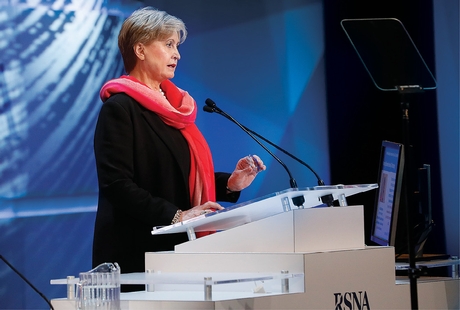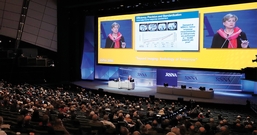Radiology Should Embrace—Not Fear—the Future
Wednesday, Nov. 30, 2016
Radiologists have an opportunity to turn fear of the future into a leadership role as cancer care enters the value-driven era, according to Hedvig Hricak, MD, PhD, Dr (hc), during her New Horizons Lecture, "Beyond Imaging: Radiology of Tomorrow."
A renowned leader in oncologic imaging, Dr. Hricak asserted that fear of new technologies like machine learning (ML) are misguided. She noted that many predictions based on fear end up being wrong, such as when David Ricardo, an economist of Industrial Age England famously predicted that mechanization would have dire consequences for humanity.

Hedvig Hricak, MD, PhD, Dr (hc) delivers the New Horizons Lecture.
"In contrast, the overall effect of mechanization turned out to be job creation on an unprecedented scale, and I think that's going to happen to our specialty," said Dr. Hricak, chair of the Department of Radiology at Memorial Sloan-Kettering Cancer Center, professor of radiology at Weill Cornell College of Medicine and professor at Gerstner Sloan-Kettering Graduate School of Biomedical Sciences, all in New York City.
For evidence, Dr. Hricak pointed out numerous examples of how radiology has provided new insight into cancer. Imaging showed that individual breast cancer lesions could have areas that test positive for human epidermal growth factor receptor 2 (HER2) and areas that test negative. Imaging also showed that a primary breast cancer can be HER2-negative, while the metastases are HER2-positive.
Imaging was pivotal in a new understanding of Phase I cancer drug trials that traditionally involved dose escalation to the maximum tolerance of patients. Some patients actually did worse with an escalated dose, suggesting that biology was more important than dose.
"Estrogen receptor imaging showed differences between biology-driven and maximum tolerable dose," Dr. Hricak said. "This is probably one of the greatest examples of patient-centered, value-driven healthcare."
Radiology will face significant challenges as precision medicine develops and matures, Dr. Hricak said. Among the key needs are a better understanding of tumor biology, improvements in clinical trial designs and integrated diagnostics for understanding tumor ecology. In therapy, the future offers unprecedented potential for expansion and new programs, provided that interventional radiologists get support in the form of research infrastructure, dedicated IR rooms and admitting privileges.
"When we give them these tools, the sky is the limit," Dr. Hricak said.
Patient selection for ablation provides an example of the promise of such new methods. For example, the presence of a mutation could predict local recurrence after ablation of lung cancers and liver cancers.
Radiomics — the collective characterization of imaging features — is a key area of development in cancer care that can serve as a predictive biomarker and a tool for the assessment of chemoresistance. Radiomics research on a high grade type of ovarian cancer has shown that the further the metastases are from a tumor, the greater the heterogeneity. This heterogeneity is predictive of a worse outcome. Researchers are linking radiomics with genomics, such as in the correlation of p53 tumor suppressor tumor mutations and phenotypic texture patterns.
Theranostics — the science of developing more specific, individualized therapies for various diseases — represent another area of great promise in the age of precision medicine. Biopsies, for example, will give information on DNA and other molecular factors.
"These are the programs we need," Dr. Hricak said. "We must realize that nuclear medicine physicians are much more than people reading FDG PET/CT scans — they too need clinics and admitting privileges."
In closing, Dr. Hricak stressed that radiologists should embrace artificial intelligence and ML as tools to improve efficiency, precision and standardization. Referencing Franklin Delano Roosevelt's famous quote, "the only thing we have to fear is fear itself," she said that great opportunities lie in the future.
"Fear is powerful, but we can turn fear into leadership — leadership for the radiology of tomorrow," she said.





 Home
Home Program
Program Exhibitors
Exhibitors My Meeting
My Meeting
 Virtual
Virtual Digital Posters
Digital Posters Case of Day
Case of Day

